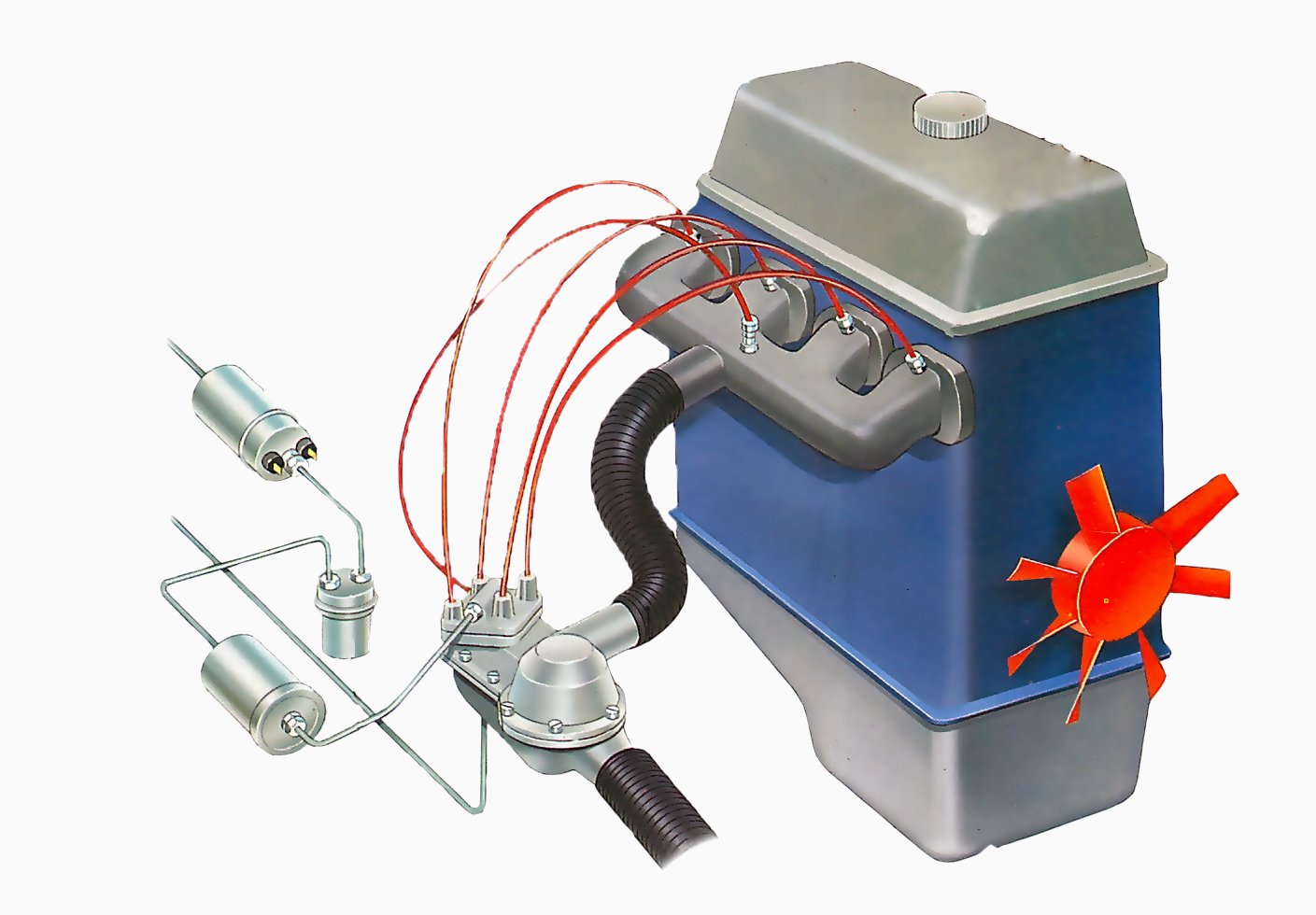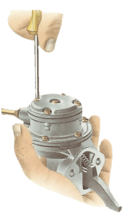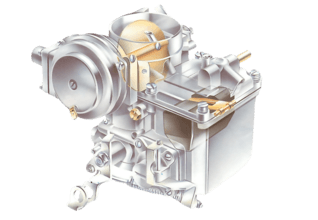For the engine to run smoothly and efficiently it needs to be provided with the right quantity of fuel/air mixture according to its wide range of demands.
Le système d'injection du carburant
Les voitures fonctionnant à l'essence utilisent l'injection de carburant indirecte . Une pompe à carburant envoie l' essence au moteur, et il est alors injecté dans le collecteur d'admission par un injecteur. Il y a plus un injecteur pour chaque cylindre distinct mais minimum deux injecteurs dans le collecteur d'admission .
Traditionally, the fuel/air mixture is controlled by the carburettor, an instrument that is by no means perfect.
Its major disadvantage is that a single carburettor supplying a four-cylinder engine cannot give each cylinder precisely the same fuel/air mixture because some of the cylinders are further away from the carburettor than others.
This video course is the best way to learn everything about cars.
Three hours of instruction available right now, and many more hours in production.
- 4K HD with full subtitles
- Complete disassembly of a sports car
One solution is to fit twin-carburettors, but these are difficult to tune correctly. Instead, many cars are now being fitted with fuel-injected engines where the fuel is delivered in precise bursts. Engines so equipped are usually more efficient and more powerful than carburetted ones, and they can also be more economical, as well as having less poisonous emissions.
Diesel fuel injection
The fuel injection system in petrolengined cars is always indirect, petrol being injected into the inlet manifold or inlet port rather than directly into the combustion chambers. This ensures that the fuel is well mixed with the air before it enters the chamber.
Many diesel engines, however, use direct injection in which the diesel is injected directly into the cylinder filled with compressed air. Others use indirect injection in which the diesel fuel is injected into the specially shaped pre-combustion chamber which has a narrow passage connecting it to the cylinder head.
Only air is drawn into the cylinder. It is heated so much by compression that atomized fuel injected at the end of the compression stroke self-ignites.
Basic injection
All modern petrol injection systems use indirect injection. A special pump sends the fuel under pressure from the fuel tank to the engine bay where, still under pressure, it is distributed individually to each cylinder.
Depending on the particular system, the fuel is fired into either the inlet manifold or the inlet port via an injector. This works much like the spray nozzle of a hose, ensuring that the fuel comes out as a fine mist. The fuel mixes with the air passing through the inlet manifold or port and the fuel/air mixture enters the combustion chamber.
Some cars have multi-point fuel injection where each cylinder is fed by its own injector. This is complex and can be expensive. It's more common to have single-point injection where a single injector feeds all the cylinders, or to have one injector to every two cylinders.
Injectors
The injectors through which the fuel is sprayed are screwed, nozzle-first, into either the inlet manifold or the cylinder head and are angled so that the spray of fuel is fired towards the inlet valve.
The injectors are one of two types, depending on the injection system. The first system uses continuous injection where the fuel is squirted into the inlet port all the time the engine is running. The injector simply acts as a spray nozzle to break up the fuel into a fine spray - it doesn't actually control the fuel flow. The amount of fuel sprayed is increased or decreased by a mechanical or electrical control unit - in other words, it is just like turning a tap on and off.
The other popular system is timed injection (pulsed injection) where the fuel is delivered in bursts to coincide with the induction stroke of the cylinder. As with continuous injection, timed injection can also be controlled either mechanically or electronically.
The earliest systems were mechanically controlled. They are often called petrol injection (PI for short) and the fuel flow is controlled by a mechanical regulator assembly. These systems suffer from the drawbacks of being mechanically complex and having poor response to backing off the throttle.
Mechanical systems have now been largely superseded by electronic fuel injection (known as EFi for short). This is thanks to the increasing reliability and decreasing costs of electronic control systems.
Mechanical fuel injection
Système d'injection de carburant mécanique Lucas
Dans le système Lucas, le carburant provenant du réservoir est pompé à haute pression à un accumulateur de carburant. De là, elle passe dans le distributeur de carburant, qui envoie une rafale de carburant à chaque injecteur, d'où il est tiré dans l'orifice d'entrée. Le débit d'air est contrôlé par une soupape à clapet qui ouvre en réponse à la pédale d'accélérateur. Comme le débit d'air augmente, le distributeur de carburant augmente automatiquement le débit de carburant vers les injecteurs pour maintenir le mélange carburant / air correctement équilibré. Pour le démarrage à froid , un étranglement sur le tableau de bord ou, sur une unité de commande à microprocesseur apporte un injecteur de démarrage à froid spécial en service , qui injecte du carburant supplémentaire pour créer un mélange plus riche . Une fois que le moteur a chauffé à une certaine température , une pastille thermique coupe automatiquement l'injecteur de démarrage à froid .
Mechanical fuel injection was used in the 1960s and 1970s by many manufacturers on their higher-performance sports cars and sports saloons. One type fitted to many British cars, including the Triumph TR6 PI and 2500 PI, was the Lucas PI system, which is a timed system.
A high-pressure electric fuel pump mounted near the fuel tank pumps fuel at a pressure of 100psi up to a fuel accumulator. This is basically a short-term reservoir that keeps the fuel-supply pressure constant and also irons out the pulses of fuel coming up from the pump.
From the accumulator, the fuel passes through a paper element filter and then feeds into the fuel-metering control unit, also known as the fuel distributor. This unit is driven from the camshaft and its job, as the name suggests, is to distribute the fuel to each cylinder, at the correct time and in the correct amounts.
The amount of fuel injected is controlled by a flap valve located in the engine's air intake. The flap sits beneath the control unit and rises and falls in response to airflow - as you open the throttle, the 'suck' from the cylinders increases the airflow and the flap rises. This alters the position of a shuttle valve within the metering control unit to allow more fuel to be squirted into the cylinders.
From the metering unit, the fuel is delivered to each of the injectors in turn. The fuel then squirts out into the inlet port in the cylinder head. Each injector contains a spring-loaded valve that is kept closed by its spring pressure. The valve only opens when the fuel is squirted in.
For cold starting, you cannot just block off part of the airflow to enrich the fuel/air mixture as you can with a carburettor. Instead a manual control on the dash (resembling a choke knob) or, on later models, a microprocessor alters the position of the shuttle valve within the metering unit. This activates an extra injector mounted in the manifold, causing it to squirt in extra fuel to enrich the mixture.
Electronic injection systems
Injection électronique Bosch
Un système électronique est commandé entièrement par une unité de commande à microprocesseur. Cette mesure de facteurs sont la température du moteur, la position du papillon et le régime du moteur pour calculer le mélange air / carburant requis par le moteur.
The main difference between electronic injection and mechanical injection is that an electronic system is controlled by a complex microprocessor control unit (sometimes called an electronic control unit or ECU), which is basically a miniature computer.
This computer is fed with information from sensors mounted on the engine. These measure factors such as the air pressure and temperature in the air intake, the engine temperature, accelerator position and engine speed. All this information allows an electronic system to meter the fuel far more accurately than the simple mechanical system, which relies on sensing the airflow alone.
The computer compares the input signals from the sensors with information already programmed into it at the factory, and works out exactly how much fuel should be delivered to the engine. It then signals the on-off valve ig the injector to open and squirt fuel into the inlet port. All this happens in a fraction of a second, the control unit responding instantly to changes in accelerator position, temperature and air pressure.
As well as improved control over fuel flow, the electronic system also operates at lower pressure than a mechanical system - usually at around 25-30psi. This makes it run more quietly than a mechanical system does.
A typical system is the Bosch LJetronic, which is fitted to a wide range of European cars. In this system, fuel is drawn from the tank by an electric pump. It is then fed straight up pipes to the injectors. The system pumps more fuel than is needed for injection - a loop circuit returns the excess to the fuel tank via a pressure regulator which keeps the pressure in the pipes constant.
The injector valves are held closed by springs, and opened by solenoids (electromagnets) when signalled to do so by the control unit. The amount of fuel injected depends on how long the solenoid holds the injector open.








